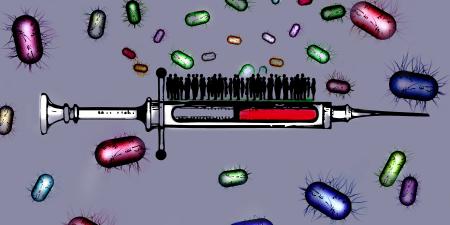Abstract
This case analysis examines obligations health care workers have to support relief efforts when an infectious disease outbreak could impact us all. How clinicians, institutions, and local communities ought to balance increased need for global solidarity in response to global disease outbreaks with concerns of local stakeholders is one specific tension this article investigates. We explore how emphasizing global health solidarity in the face of highly hazardous communicable diseases can help mitigate global risk.
Case
Dr W is a hospital administrator at BB academic medical center in the United States. BB has a prominent global health program, and Dr V, an expert in epidemic responses, has expressed interest in working abroad with Médecins Sans Frontières (MSF—Doctors Without Borders) on the current Ebola outbreak. Upon returning from work in prior Ebola outbreaks, clinicians have been monitored in isolated Ebola units until it can be confirmed that they have not contracted the virus. Despite staff having been “cleared,” however, some BB patients worry about attending appointments or coming to a hospital where “some doctors and nurses have been around Ebola.” Even some members of BB’s staff have stated that they will not treat patients who have a disease as deadly as Ebola out of fear for their own safety. Concerned about bad publicity and media attention, the BB board of directors has asked Dr W to dissuade Dr V from continuing international work on Ebola containment, suggesting that “there are other important global health projects that don’t scare people so much.” Dr W wonders how to respond.
Commentary
Health care workers (HCWs) are holders of privileged knowledge and of the public’s trust; they have a sacred duty in society—that of healers. In return for the public’s trust, they owe a duty to care based on their fiduciary relationship to patients.1 In the legal sense, the phrase a duty of care stems from a special relationship between a physician and his or her patient—a relationship that is voluntary and entered into by mutual agreement.2 Certainly, this definition is clear when applied to a cardiologist treating a patient presenting at the hospital with chest pain. However, what is the obligation of an expert in epidemic responses, like Dr V, to those suffering from highly hazardous communicable diseases in the midst of an epidemic? There is little consensus on the extent to which health care workers have a duty to provide health services in an outbreak or what that duty might entail.3 Explicating the duty to care in a public health emergency of international concern (PHEIC) comes with hurdles. The challenges stemming from a PHEIC might include: (1) difficulty in defining hospitals’ obligations to multiple groups—employees, patients, and the community; (2) providing safe working conditions for HCWs; (3) operating in a health care system with different standards of care; and (4) providing compensation and time off for HCWs to travel to impacted areas.1
Without clear formulation of the duty to care in a PHEIC, HCWs as well as academic medical center leadership may end up overwhelmed by the challenges of serving in an outbreak-afflicted area. Yakubu et al assert that there is not a professional duty to treat in these circumstances, only a moral one.4 Yet here we will argue that, given the landscape of outbreaks of international concern, Dr V’s expressed interest and altruism in serving abroad are not merely issues of personal conscience; they exemplify the value of solidarity that institutions like BB academic medical center and society should encourage.5
Global Health Solidarity
British bioethicists Prainsack and Buyx define solidarity as an “enacted commitment to carry ‘costs’ (financial, social, emotional, or otherwise) to assist others with whom a person or persons recognize similarity in a relevant respect.”6 Our shared vulnerability to highly hazardous communicable diseases (HHCDs)—diseases that only know the boundaries of biology and don’t respect national borders—should incite a shared responsibility to fight an HHCD outbreak together.7 The similarity that exists between a patient at BB academic medical center and an individual living in the Democratic Republic of the Congo (DRC) is that both are increasingly united in their vulnerability to emerging threats. Consider a US citizen returning from a visit to the DRC on a full plane back to the US sitting in seat 52B. Two days later, a passenger who had been seated in 52A begins to feel nauseous. Ten days after returning to his home, the passenger who had been seated in 52C visits the emergency room with a high fever and vomiting. Even with safeguards, exposure can build exponentially. An outbreak in the DRC, if not contained, will spread to countries on different continents, just as it has spread to countries within Africa. Although the United States and Europe have been successful in treating patients with known Ebola virus disease (EVD) through airlifting them and treating them in specialized biocontainment units, these are limited resources.7 If exposures and known cases breach the limits of those resources, controlling the spread of EVD is likely to tax the US health care system and threaten the health security of the US population. The duty to care for those suffering on the other side of the globe may be strengthened by greater recognition of our shared vulnerability and a commitment to solidarity toward a shared threat. Solidaristic practices would entail taking action to care for those suffering abroad with the support of the government and institutions, just as if the outbreak were on US soil.8
The duty to care for those suffering on the other side of the globe may be strengthened by greater recognition of our shared vulnerability.
Dr V’s desire to serve in an area affected by the outbreak, putting her life at risk, demonstrates solidarity—to be in solidarity with others is to act on their behalf and to accept the costs of doing so.8 However, her risk is not hers alone. Dr V’s actions stand to affect BB’s patients as well as the community at large. As such, BB academic medical center’s board of directors is correctly concerned about the risk of exposure to current patients and assuaging fear of community members, who, along with BB patients and some staff, might perceive the ongoing work done by BB medical center’s participating staff as a threat to their safety. BB patients and staff may be especially concerned about being exposed to Ebola by BB clinicians returning from working in the outbreak-affected area.
Health care institutions should have a strategy for managing the risk of exposure to patients and employees from returning staff who have worked in outbreak-afflicted areas, as it is possible to manage the risk of this exposure effectively. Clinical staff should be required to register their travel and prospectively commit to complying with Centers for Disease Control and Prevention guidelines for managing potential Ebola virus exposure9 on their return, as these guidelines have proven effective in US monitoring of health care professionals returning from EVD outbreak environments.10 With these controls in place, physical risks are manageable; they should not dominate the discourse about supporting international service.
Supporting HCWs’ service in a PHEIC through organizations like MSF contributes to their safety and mitigates their risk of contracting disease. However, an additional concern for BB’s board of directors is that the BB patient community feel adequately safeguarded; BB academic medical center upholds its reputation as a trusted institution in the community. Dr W should respond to BB’s board of directors by providing a clear explanation of the physical risks to HCWs working with MSF and the likelihood of their contracting an HCCD. In addition, Dr W should detail a plan to mitigate the risk of exposure to patients along with a communication strategy designed to provide transparent responses to patients’ concerns and to garner trust within the BB community.
Solidarity is often an implicit prerequisite among groups for the delivery and maintenance of important social infrastructures.7 Public health programs such as vaccination campaigns or routine water sampling—or infrastructure like the justice system—work on behalf of the public and are funded through the government. Solidarity could underlie the approach to global health threats, as academic medical centers with prominent global health programs, such as BB, could commit a portion of their funds to strengthening health care infrastructure in affected countries. If BB academic medical center’s board of directors see the community as vulnerable to the threat of HHCDs, supporting a range of efforts to contain a disease might be easier to “sell” to their patients and community. BB academic medical center and hospitals who mobilize qualified HCWs to work in affected areas could not only meet the needs of desperate patients but also contain Ebola at its source, averting global risk.
Solidarity in Practice
Pursuing global health solidarity could be an aspirational component of a global health program’s mission, but implementing it is not without difficulty for academic medical centers. Supporting health care workers who go abroad to assist in mitigating an outbreak takes careful consideration on the part of academic medical centers concerning the risks employees may face—ranging from contracting HHCDs to potentially working amidst political instability and violence. For academic medical centers with global health programs, steps should be taken to ensure that staff members in the field are adequately supported and that the institution has staffing coverage, especially when sending a team of health care workers for an extended period of time.
Local support. Uncertainty surrounds the continued availability of medical evacuation for staff, and there may also be concerns regarding violence and civil unrest in Ebola-affected countries.11 Dr V cannot be expected to shoulder this risk alone but rather should receive support from BB academic medical center, which might worry about whether it can adequately protect its employees. To minimize the risks and maximize the benefits of HCWs’ service, academic medical centers and other institutions should require that HCWs who volunteer to serve do so only through established and qualified organizations and should help HCWs to inform themselves fully of all residual risks and uncertainties.5
Staffing coverage. BB academic medical center’s commitment to support HCWs serving in an outbreak-afflicted area also requires consideration of the strain it will place on its staff and patients. Providing care in Ebola-affected regions can involve an extensive time commitment for clinicians—not only time spent deployed but also several days of training and sometimes several weeks postdeployment away from work for monitoring, if required.5 On the clinical side, Dr V’s time away from work could increase BB clinicians’ patient load, create strain on colleagues who are tasked with covering extra responsibilities, and jeopardize continuity of physician care.Although it will be necessary for academic medical centers to address these concerns, the number of HCWs willing and qualified to serve is small, and the strain on institutions and staff members is likely to be minor.5
Conclusion
In an editorial in the Bulletin of the World Health Organization, Flahault et al argue that respect for human rights and solidarity should be at the heart of each country’s national security agenda; furthermore, the authors claim that these values are consistent with the motives of many people who provide health services in public health emergencies.12 BB academic medical center and its leadership should consider how solidarity fits with the mission of the institution’s global health program. Solidarity practices should be communicated to and reinforced within the institution and community. Such efforts can make inroads in garnering support from BB staff, patients, and community stakeholders in supporting HCWs willing to act on their sense of solidarity.
References
- Thompson A. Bioethics meets Ebola: exploring the moral landscape. Br Med Bull. 2016;117(1):5-13.
-
Shensky ES. What is a healthcare provider’s duty to care? National Law Review. October 19, 2015. https://www.natlawreview.com/article/what-healthcare-provider-s-duty-care. Accessed on July 9, 2019.
-
Ruderman C, Tracy CS, Bensimon CM, et al. On pandemics and the duty to care: whose duty? Who cares? BMC Med Ethics. 2006;7:e5.
- Yakubu A, Folayan MO, Sani-Gwarzo N, et al. The Ebola outbreak in Western Africa: ethical obligations for care. J Med Ethics. 2016;42(4):209-210.
-
Mello M, Merritt M, Halpern S. Supporting those who go to fight Ebola. PLoS Med. 2015;12(1):e1001781.
-
Prainsack B, Buyx A. Solidarity: Reflections on an Emerging Concept in Bioethics. London, UK: Nuffield Council on Bioethics; 2011.
- West-Oram PGN, Buyx A. Global health solidarity. Public Health Ethics. 2017;10(2):212-224.
-
Uyeki TM, Mehta AK, Davey RT Jr, et al; Working Group of the US-European Clinical Network on Clinical Management of Ebola Virus Disease Patients in the US and Europe. Clinical management of Ebola virus disease in the United States and Europe. New Engl J Med. 2016;374(7):636-646.
-
Centers for Disease Control and Prevention. Interim US guidance for monitoring and movement of persons with potential Ebola virus exposure. https://www.nalc.org/workplace-issues/body/2014-10-29-CDC-Update-on-monitoring-and-movement-of-persons-with-Potential-Ebola.pdf. Updated November 28, 2014. Accessed May 28, 2019.
- Stehling-Ariza T, Fisher E, Vagi S, et al. Monitoring of persons with risk for exposure to Ebola virus disease—United States, November 3, 2014-March 8, 2015. MMWR Morb Mortal Wkly Rep. 2015;64(25):685-689.
-
Mangan K. Universities curtail health experts’ efforts to work on Ebola in West Africa. Chron High Educ. 2014;61(9):A12.
-
Flahault A, Didier W, Zylberman P, et al. From global health security to global health solidarity, security and sustainability. Bull World Health Organ. 2016;94(12):863.



